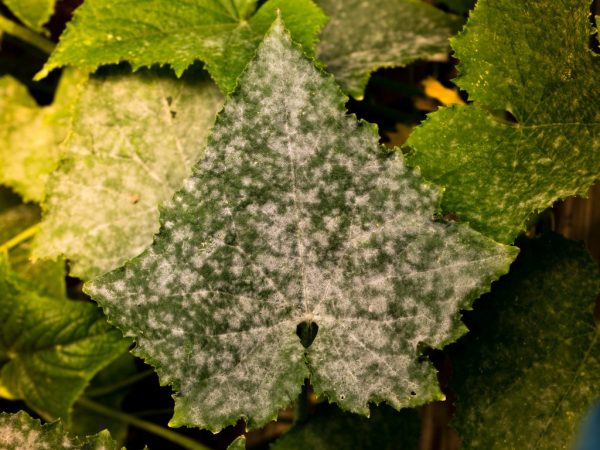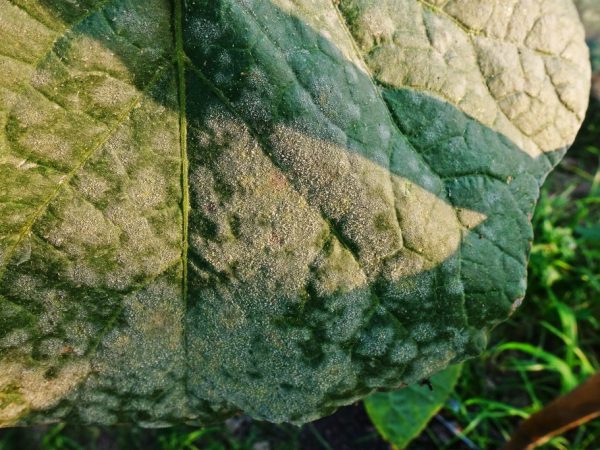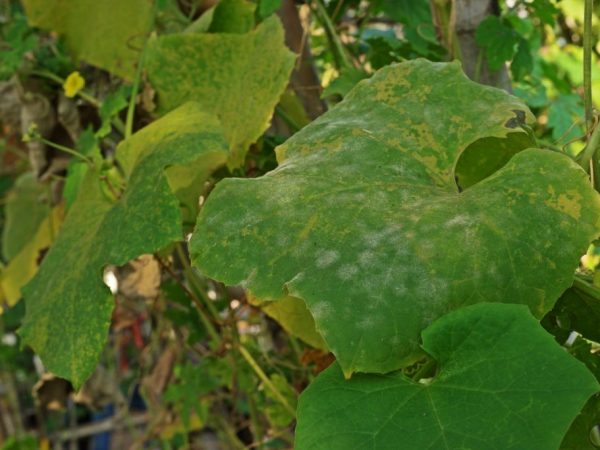Powdery mildew on cucumbers
Each gardener, growing cucumbers on his site, hopes for a high and high-quality harvest. But this does not always work out. Pests that affect vegetables can become obstacles in their path. Powdery mildew on cucumbers is one of the most unpleasant diseases.

Powdery mildew on cucumbers
To preserve the culture, you need to know everything about the pest. Otherwise, it will cause great damage to the crop.
About the disease
Powdery mildew is caused by a fungus, which, falling on the leaves of a cucumber, begins to grow. A sign of their defeat is white spots with a rusty tinge. Over time, they merge into a single area and spread to the opposite side. Less commonly, the disease affects the stalks and fruits. The damaged plant slows down its growth. If you do not apply measures, the leaves of the bushes become wavy, and soon dry up completely. As a result, you can lose up to 70% of the crop.
There are several reasons for the onset of the disease. Among them it is worth highlighting:
- cool weather;
- weakened plants;
- excessive or insufficient moisture;
- incorrect fertilization.
Cucumber powdery mildew feels good at a temperature of 16-20 16С. It develops in rainy weather when the air humidity is high. At temperatures above 20 ° C, the mushroom does not spread.
Temperature drop
In greenhouses, it appears most often near doors, in greenhouses - near frames. In places where they do not adhere well to the ground, it becomes cold and wet. There are favorable conditions for the development of the disease. But the bushes that grow in open areas of land are most susceptible to it. Night and day jumps in temperature lead to the weakening of the plant. Then they become more vulnerable.
Watering
Excess moisture also provokes powdery mildew as well as its lack. Therefore, the irrigation regime should be properly observed, especially if the bushes are weakened. Weakened plants need to be watered every three days; about 1 liter of liquid should be spent on one bush during the period of intensive growth. During the growing season, the norm is also 1 liter of water per 1 bush. But, you need to strictly monitor so that there is no stagnation of liquid near the claws. If the summer is rainy watering is carried out only when necessary. That is, only if it does not rain for more than 3-4 days.
One of the reasons for the activation of the pathogen is the lack of calcium in the soil and the high content of nitrogen in it. It is worth strictly monitoring the amount and warehouse of the drugs used. Calcium dressing is applied once a month no more often. The proportions must be observed in strict accordance with the instructions for the selected drug.
Disease prevention
Cucumber treatment is always a difficult process. In order to prevent the appearance of powdery mildew in the garden, it is worth taking preventive measures:
- Always observe crop rotation. This way, fungi will not accumulate in the soil.
- After harvesting, it is necessary to collect all plant residues, because the causative agent of the disease does not die during the winter. For the same reason, it is worthwhile to disinfect the soil during this period.
- The temperature in the greenhouse must be kept above 20 ° C. In open areas, you can cover the ground with plastic wrap, which will prevent hypothermia.
- The bushes should be watered only with warm water.
- Cucumbers can be sprayed with Quadris.
- For feeding, use products containing potassium and phosphorus.
Using such methods, you can prevent disease. Then the growing process will not be difficult.
Means to fight the disease

Disease can be fought
The incubation period after infestation of cucumbers is about 7 days. Therefore, signs of defeat are not immediately visible. To see the pest in time, you need to regularly inspect the plants. Victory can be obtained if you know how to deal with powdery mildew on cucumbers.
Folk remedies
If the gardener does not want to saturate the fruit with harmful chemicals, you can try using environmentally friendly products. They have a good effect and are not inferior to drugs that are bought in stores.
Soap solutions
Plants are treated with a solution, which is prepared as follows: for 1 liter of milk they give 25 drops of iodine and 20 g of crushed laundry soap (you can take liquid soap). Spraying is carried out once every one and a half weeks.
Milk solutions
Other dairy products will also be effective. Serum diluted in water will create a thin film on the leaves, which will be an obstacle to further multiplication of the fungus. Treatment can be done with kefir (even spoiled), yogurt and sour milk. The lactic acid bacteria they contain have a detrimental effect on fungi.
Manure infusion
Against the pest, it is worth spraying cucumbers with an infusion prepared on the basis of manure. It is poured with cold water in the amount of 1/3 of a bucket and left for 3 days. The liquid must be filtered and diluted with water in a ratio of 1:10. Also, an infusion of mullein or nettle is used as a remedy.
Weed infusion
Even garden weeds can be useful: 1 part of them in a crushed form is poured with 1 part of hot water. After they are infused for 3 days, filter. Processing is carried out in the evening every day.
Soda-soap solution
You can use another folk remedy for powdery mildew on cucumbers. Its ingredients are always at hand. To prepare the solution, take 4 g of soda and 4 g of shabby soap. This mixture must be diluted in 1 liter of water until smooth. Processing is carried out every week 2 times a day.
Chemicals
If folk remedies do not help, stronger substances should be used. When the infection is at an early stage, you can use:
- fungicides;
- biofungicides.
From the first category, there can be such agents as VDT, Tiovit and Jet, which are used for processing only during the growing season. They are available in powder or aerosol form. On the other hand, Fitosporin, Planriz. The bacterial components of these drugs prevent fungi from multiplying. They can be used during the formation of fruits, because they are safe.

There are many remedies to eradicate disease
To combat powdery mildew on cucumbers, it is worth using spraying with calloidal sulfur. It is taken in an amount of 15-20 g and diluted in 10 liters of water. For the Nerosimny variety, it is worth taking only 10 g of sulfur. Processing is carried out systematically every 7-8 days. In cloudy weather, the remedy will not be effective. To prevent the culture from getting burns, it is worth spraying it at a temperature below 30 ° C.
Alternative treatment advises to fight the disease and use a mixture of copper sulfate (7 g), liquid soap (100 g) and water (10 l). It is dissolved in this way: separately copper and separately soap, then gradually pour in, stirring.
If the disease has strongly affected cucumbers, more poisonous drugs are used to combat it. It is worth considering that cucumbers have a short growing season. And for some time they will not be allowed to be eaten. This even applies to resistant types of vegetables.
Penosporosis (downy mildew)
Downy mildew is defined by light yellow spots on the leaves of the bushes.
They turn brown over time. On their lower part, a grayish-purple or black-brown plaque forms. If you do not apply measures, then the plant dies in 2-3 days.
For preventive purposes, a decoction of tansy is used. It is prepared in this way: fresh (300 g) or dried (30 g) tansy is poured with water (10 l). Leave for a day. Then boil for 1 to 2 hours. Filter the cooled liquid and spray the soil with it.
To combat penosporosis, Bordeaux liquid is used. To prepare it, take 100 g of copper sulfate and 10 liters of water. Fresh lime is added. It should be noted that vegetables can be consumed in 5-7 days.
Powdery Mildew Resistant Varieties
Most types of cucumbers are susceptible to this disease. But there are varieties that are resistant to it, namely:
- ant F1;
- bee-pollinated variety;
- Masha F1;
- goosebump F1;
- a boy with a finger F1;
- benefit;
- Alexeyevich.
These are well-known species that are often planted by gardeners. They are also resistant to viral mosaic diseases and cladosporia. Most disease-resistant plant species also show high resistance to mechanical stress and temperature extremes.
Conclusion
Most gardeners are faced with the problem of the defeat of cucumbers with powdery mildew. To overcome it, you need to make a lot of effort.
The cultivation process will delight the result when using effective methods of pest control. The yield will be high if they are combined with the rules of cucumber agricultural technology.


